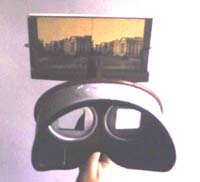
When we talk about three-dimensional or stereo photography, we always refer to a pair of frames (taken from two distinct points), whose simultaneous observation allows the perception of the three-dimensional image of the photographed object. There are many methods that man uses to observe the three-dimensional photographic image: some require more or less sophisticated tools, others a simple workout. Here, however, we are primarily concerned with understanding the mechanism that our brain uses when performing dimensional analysis. Let's start by examining the optical apparatus, that is, the eye, whose operation is often assimilated to that of a camera: in fact, it is a particular darkroom equipped with a lens (crystalline), a diaphragm (iris) and a sensitive surface (retina); however, the shutter and the possibility to fix the image are missing, so if we think about it we could compare the eye to a camera, but there is still another feature that we cannot absolutely overlook and it is the continuous mobility of the same . In reality, the sensitivity of the retina is not uniform and is maximum in a particular point (fovea), which, thanks to the possibility of rotation of the eyeball, is continuously moved to the most interesting areas of the projected image. The projecting beam passing through it is called the visual axis. In making the dimensional analysis of any object, the brain uses different methods of survey: perspective, comparison of the two images projected on the retina and triangulation. Of the three, the first two essentially serve to identify the elements to be analyzed, while the third detects the position of the points observed by means of an authentic triangulation based on the distance between the centers of rotation of the eyeballs and on the vertex the intersection of the axes visual. In truth, it is not that the brain measures, for each point, the angles formed by the visual axes with the base and performs the relative calculations to derive the three coordinates in an orthogonal Cartesian reference system, but continuously stores the data after having subjected them to occurs. For example, in the first months of life, before being able to take an object, the child must develop his own survey program. Assuming that both eyes are functional, before starting the gripping operations, he must identify the position of the object that interests him and to do this he can:
- make use of perspective; but he must have already memorized the dimensions of the observed object, otherwise he will believe he has an airplane at hand, which appears small only because it is very far away;
- use stereoscopy; but he must have acquired enough experience to be able to establish the distance of an object on the basis of the different width of the two images projected on the retina of his eyes;
- perform triangulation; but must have already memorized the law of variation of the angle formed by the visual axes as a function of the distance of the observed point.
Obviously, the survey program is not elaborated by the brain on the basis of mathematical calculations or graphic representations, but rather with a series of attempts whose results constitute the indispensable database for any new experience. When new situations arise, our brain returns to behave like that of the child; to convince ourselves, let's try a simple experiment, asking one of our interlocutors to place the tip of a pencil on that of a similar one, which we hold in hand at the height of his eyes. If the person subjected to us by the experiment keeps both eyes open, he will have no difficulty touching the tip with his pencil, but if we ask him to keep one eye closed, he will have to make multiple attempts to complete the operation. After the first failures he will try to observe the pencil (and therefore to detect its position) with both eyes before closing one to repeat the attempt, or he will move the pencil along its visual axis until it meets the other: in short, its behavior will not be very different from that of the child. If we still want to undermine our interlocutor's detection system, we can ask him to rest the tip of the pencil on a wire that we will take care to stretch to the height of his eyes in the plane of the visual axes. Even in this case, despite the use of binocular vision, his brain is unable to triangulate: in fact, the uniform surface of the wire does not allow him to identify a particular point on which to converge the visual axes, the angle of which is indispensable for determine the distance. If, on the other hand, we arrange the wire vertically, our interlocutor will have no difficulty: in fact, accustomed as he is to maintaining the coplanarity of the visual axes, he will easily make them converge at the intersection point of the wire with the plane they determine.
��